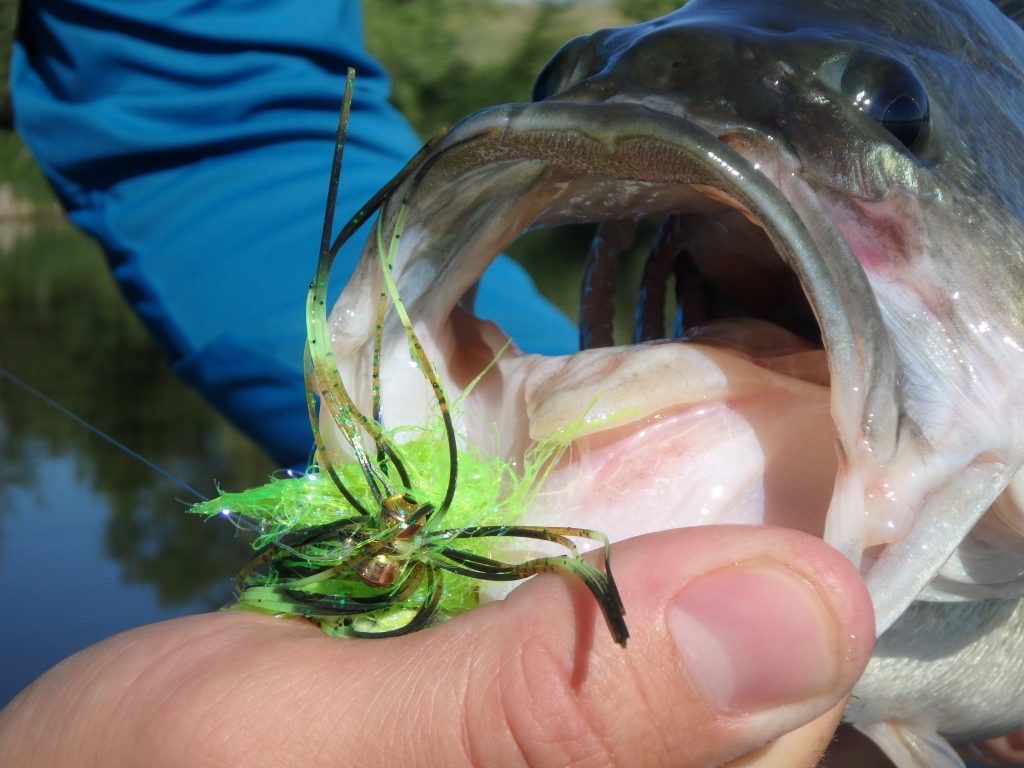Summertime fly fishing for bass on the prairie of South Dakota is one of our favorite things to do, and it's a nice break from fishing the same old rigs for trout. Don't get me wrong, I love trout fishing in the Black Hills - it's just a nice change of pace to get out the 8 weight and some 15 pound Maxima. Fly fishing for largemouth is a lot different than throwing size 18 caddis to a rising brown trout, and most of your delicacy goes out the window. There are a ton of options within a couple hour drive from the hills for the adventurous warmwater angler as well, and very little of it is getting fished much at all!
One of the classic ways to fish bass on a fly rod, and one of the most fun, is to fish surface poppers and sliders. This is generally an early morning or late evening affair - largemouth are a lot more likely to come up to the surface under low light and indirect light conditions than if the sun is directly on their heads. This time of year, if you can be on the water between 5 and 6 in the morning, you'll find more success on the surface than later in the morning. There's a ton of different patterns that can work well, but Boogle Bugs are some of our personal favorites. These little guys pack a punch, and make a ton of noise with the concave popper head which attracts fish from a pretty substantial area. The larger versions of these poppers are a size 4, and are large enough to attract big bass, but still small enough that bigger bluegills and crappies can get them in their mouths. The key to fishing just about any surface popper is to go
way slower than you think you need to go. Cast your popper next to a likely looking weededge or bank, and let it sit until the waves from the fly hitting the surface are dissipated. Then give it a good, solid strip to make the fly make a big racket and to throw some water out in front of it. Let it sit until the waves are gone again, and repeat until your fly is out of the likely looking spot. It's painfully slow to begin with, but largemouth can be skeptical fish and often need a few seconds or even a minute to check out your fly before they commit to it. Oftentimes, the strike is very subtle and you might think it's a bluegill or crappie toying with it until you set the hook and a five pounder explodes out of the water. Make sure you give the fish a second or two after the initial strike to make sure they have it - if you set the hook too soon, you'll be disappointed when you don't stick 'em. Booglin' is one of our favorite ways to fish for bass, and the visual aspect of it is a ton of fun!

Average Prairie Largemouth
If you're not out early or late, fishing subsurface is generally a better bet to hook a few fish. As with fishing a surface pattern, the slower you can make yourself go the better off you'll be. Our all-time best pattern for subsurface fishing for largemouth is Pat Ehler's Grim Reaper. It's nice and heavy so it gets down well, and the combination of the rattle, ultrasuede tail, and a whole pile or rubber legs makes for a wiggling, loud fly that largemouth can't pass up. Various color combos work well, but we've had the best luck on chartreuse, black, and brown. The location of the fish can really vary depending on the time of summer, temperatures, etc., but they can generally be found in 3-10 feet of water and oftentimes around structure like trees and weededges. I usually fish a floating line, with a leader somewhere in the 9 foot range and 15 pound test or so. Cast your fly into a likely looking spot, and let it sink until it hits the bottom. Give it a long, slow strip and then let it sit again. Most of the time, this is when a bass will pick up the fly and start swimming off with it. I generally just watch the tip of my fly line and wait for it to twitch or start moving rather than feeling the strike itself. When you get a strike, strip until you're tight to the fish and then pull back real hard. Largemouth are almost always near something that you can get snagged on or hung up on, so when you hook one pull hard and get the fish up to the surface where you can fight it without being worried about getting snagged up.

Ehler's Grim Reaper to the face.
We've been bass fishing on the fly a fair amount over the last few years, and have been consistently catching some really quality bass. For the adventurous fly fisherman looking for a different experience and to learn how to catch a few bucketmouths on the fly, we're offering a half day bass guided trip. We'll leave early so we have the best opportunity to get into a few bass, and have a chance to fish both poppers and subsurface flies. Give the shop a call to book a morning with one of our guides! If you're more of the DIY type, swing by the shop and we can get you squared away in the equipment department and show you a few places to check out.
Ryan
 Average Prairie Largemouth
Average Prairie Largemouth Ehler's Grim Reaper to the face.
Ehler's Grim Reaper to the face.
 Average Prairie Largemouth
Average Prairie Largemouth Ehler's Grim Reaper to the face.
Ehler's Grim Reaper to the face.